Create email campaigns
Bloomreach Engagement lets you send personalized email campaigns to targeted customer segments. You can use a simple visual editor or the traditional HTML builder.
This article explains how to:
- Create email campaigns in Bloomreach Engagement
- Use the basic settings
Watch this short introductory video about this feature.
Important
To send emails from Bloomreach Engagement, you must integrate a supported email service provider. Review the available integrations If you need help, contact your dedicated consultant or our Support team.
Create email campaigns
You can create an email campaign in 3 ways:
- Create a standalone email campaign in Campaigns > Email campaigns.
- Use an email node as part of a scenario.
- Reuse template in the Asset Manager. You can choose a project template or predefined template and edit it before you send it.
The process of creating the template and related settings is the same in all cases. The only difference is how you define your audience:
- In scenarios: You can specify the audience with a complex set of conditions.
- In standalone campaigns: You can only use customer and event filters.
Customer profile requirements
To send emails to customers, make sure each customer profile includes:
- Email attribute: If it's missing or empty, the campaign won't send the message.
- Valid email format: The email must include the
@symbol. If it's missing or formatted incorrectly, the message won't send. - Lowercase format: Email addresses must be in all lowercase letters.
Choose your email builder
After creating a new campaign in the Campaigns section or double-clicking the email node in Scenarios, you'll see 3 options:
- Use the visual builder to build a new email.
- Use the HTML builder to build a new email.
- Reuse a template you already created in the Asset Manager.
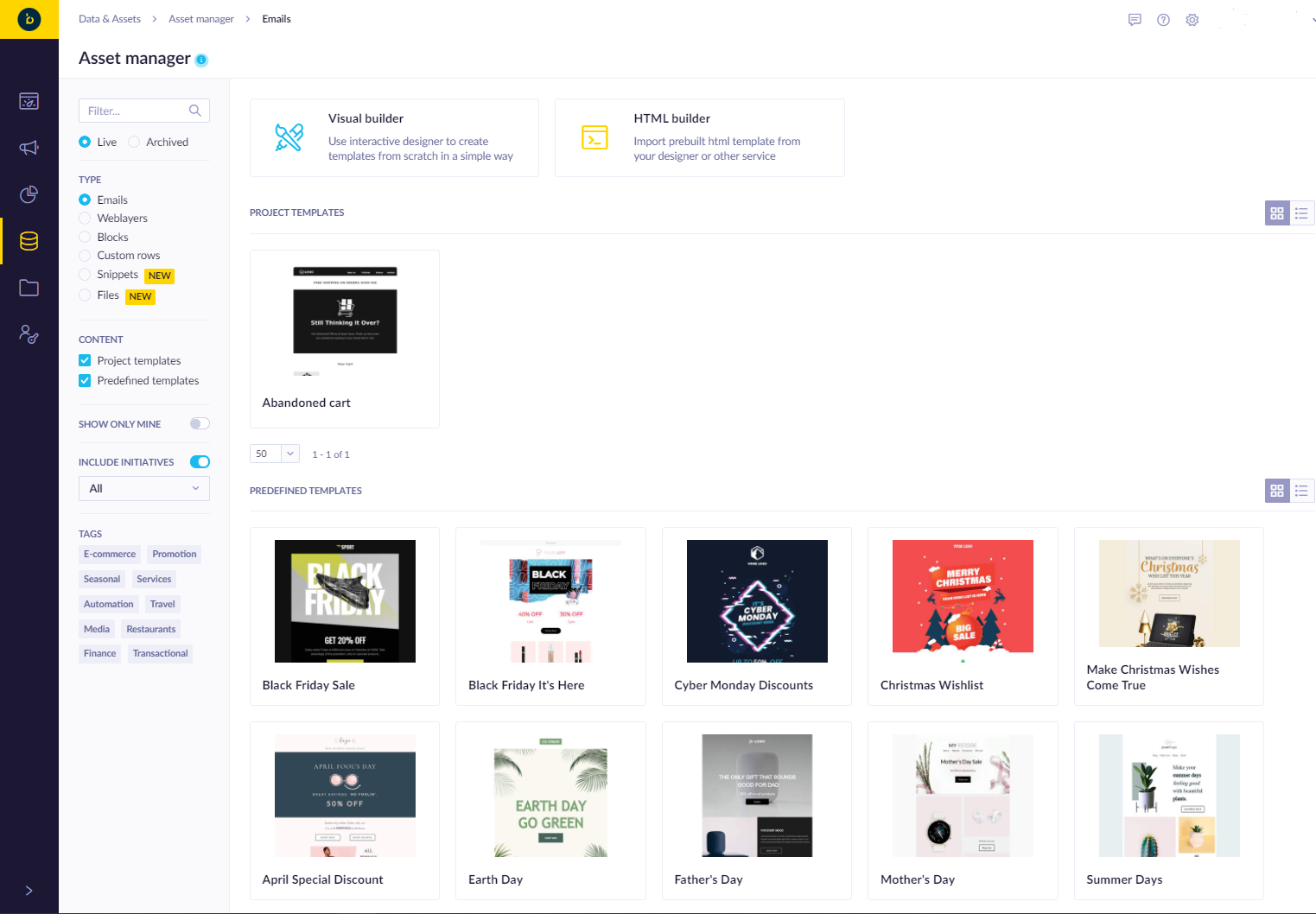
Use the visual and HTML editor
To learn how to create an email template in Bloomreach Engagement, read the Email Editors article. This article explains the settings related to sending an email campaign.
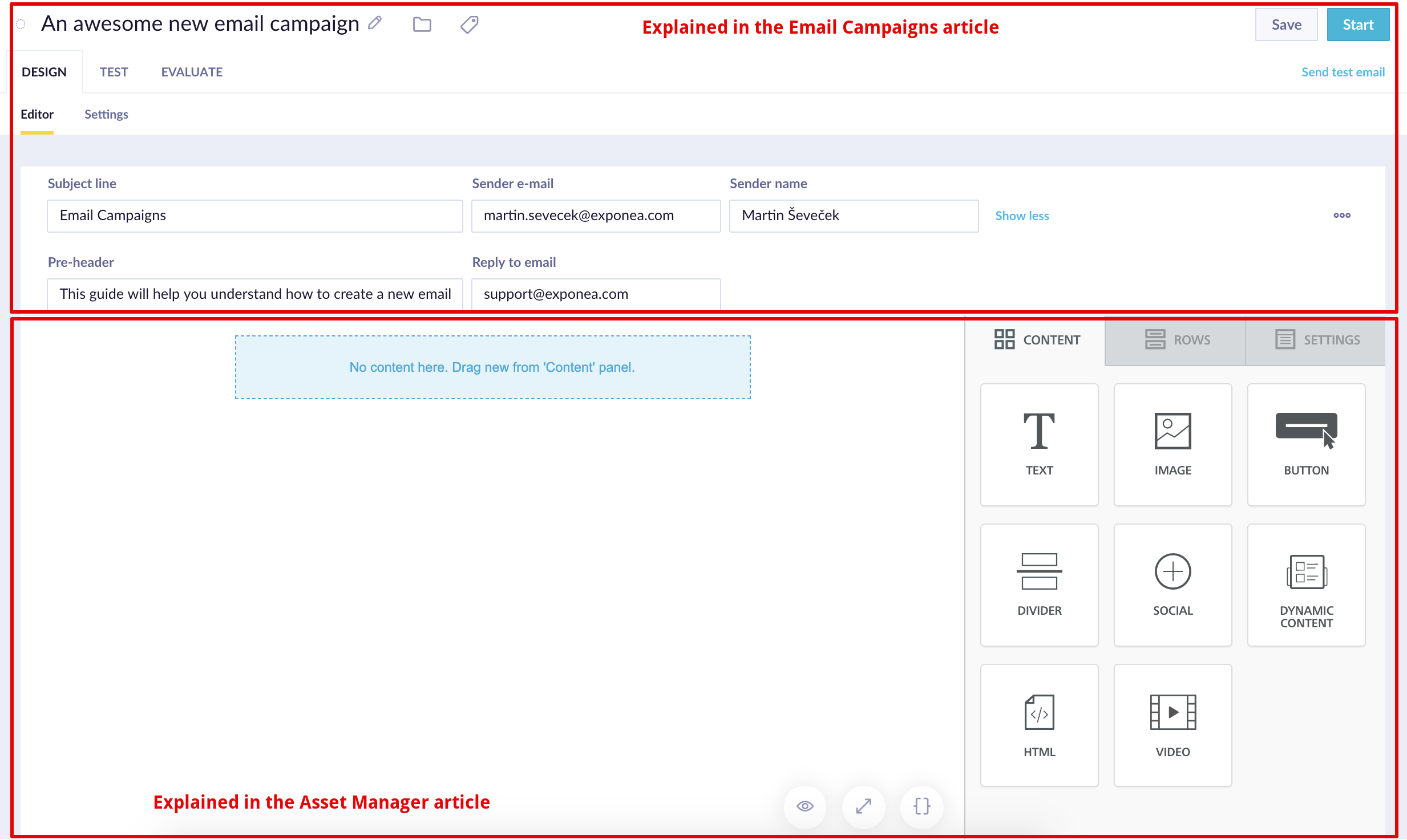
Note
We recommend using the "Do not stack on mobile" option under the Rows tab. You can achieve a responsive template by switching it off. Otherwise, your template might not look good because it's not responsive.
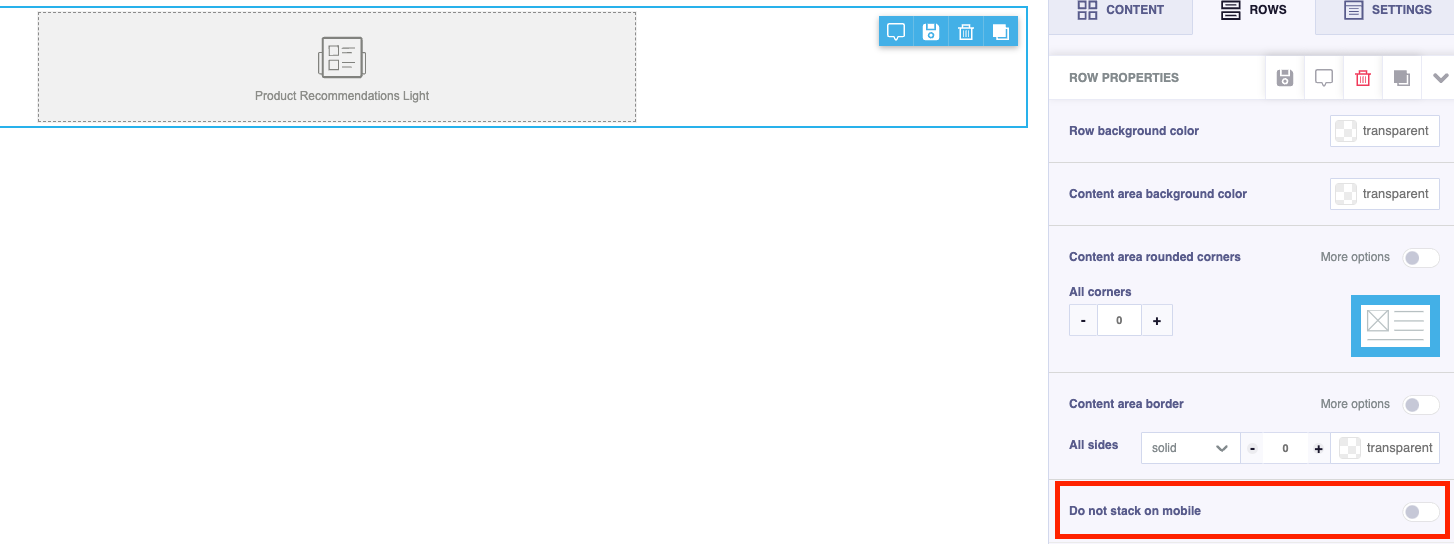
Image size limitations
- Maximum image size: 20MB
- Images wider than 1920px will be automatically resized
- If a resized image is a GIF, the animation might stop working
Important
The HTML content in the Visual Editor doesn't accept the logical operators
<=. The workaround for this is to use the character code for the<and sign<=.
Subject and sender details
In the panel above the email editor, you can:
- Define the subject of your email.
- Set the sender's email address and name.
- Choose which integrated email service provider (ESP) to use.
The menu allows you to:
- Add language versions.
- Change the template you are working with.
- Save your current work as a new template, which you can use later.
- Download your work as an HTML template.
Language versions
You can create a separate version of the email campaign for each language defined in your project settings. Access this function by clicking the three dots on the top-right side of the email builder, then click Add language version.
The system automatically chooses the correct language version for individual customers based on the language attribute in their profile. When a customer doesn't have a language set, the default template is used.
When you create a new language version, the default template is copied. However, if you change the default template, the copies won't be updated.
Jinja code attributes
If you use Jinja code {{customer.language}} attribute in the HTML Email builder, the Editor View forces the email to render as if the customer had the language equal to the current editing tab (default or selected). A client with Slovak language might render empty space or another selected language in the Editor View. To see the corresponding customer language, use the Test Tab.
Interactive tour
Learn how to deliver different language copies within emails with an interactive tour.
E13 14 steps, 3 minutes
View email in browser option
This feature lets your customers open an email that doesn't display correctly in their email client (like Gmail). The email content is stored on our platform and remains accessible via a Content Delivery Network (CDN) for 90 days.
How to set it up:
- Insert the Jinja tag {{email.view}} in your email or email template. It'll be replaced by the "View in Browser" link.
- Send your email campaign.
- If a customer has trouble seeing the email, they can click the "View in Browser" link to see it correctly in their browser.
Set default email settings
You can set default email settings after clicking on the settings icon in the top right corner under Project Settings > Channels > Emails as shown in the pictures below.

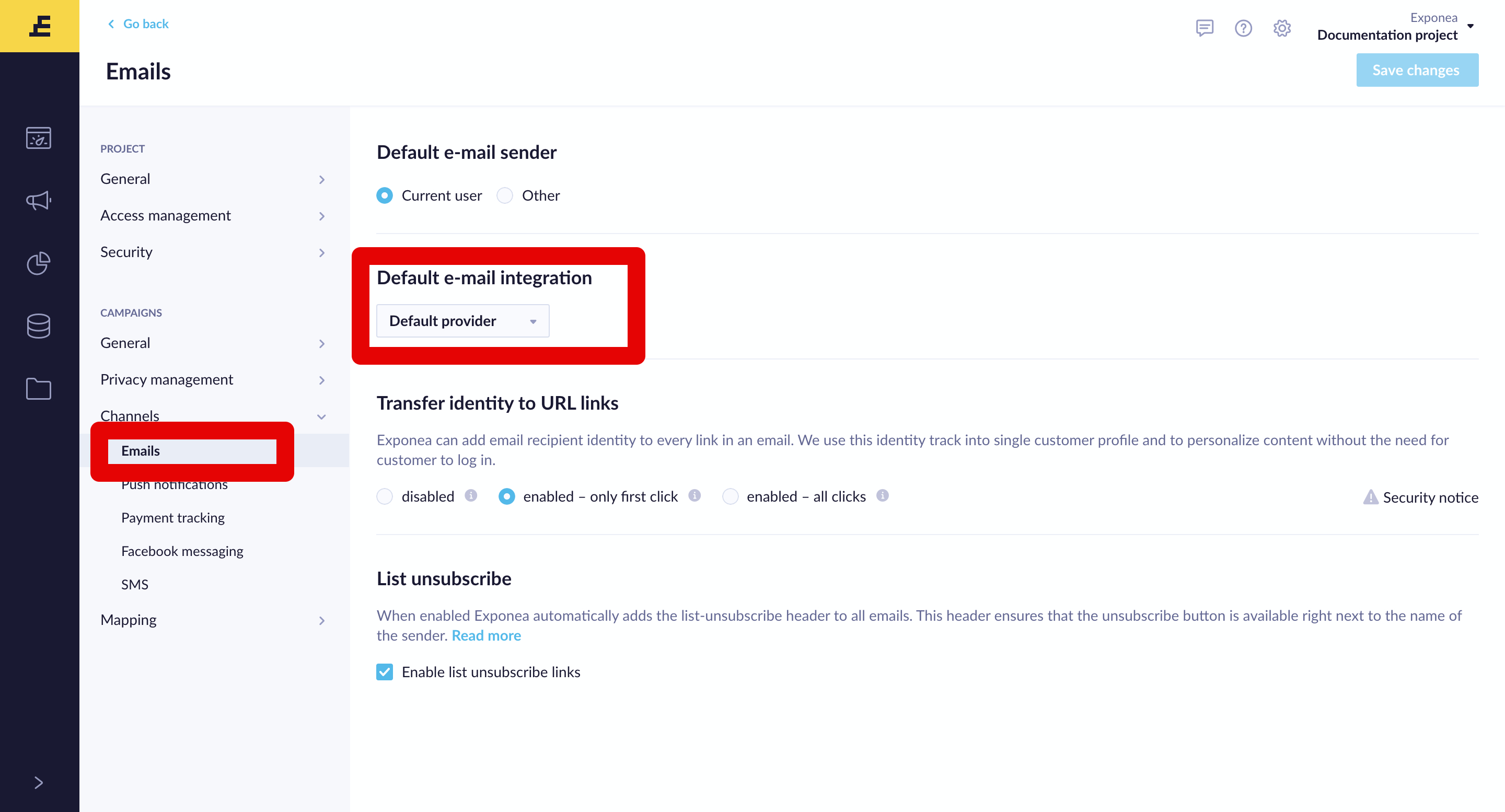
Here you can set the default email sender.
Pre-header and reply to
Click "Show more" in the upper control menu to reveal these features:
- Pre-header: Set custom text that displays next to the subject in email clients. A relevant preheader can increase open rates and engagement. We recommend keeping it between 80-100 characters, though some devices might show as few as 30 characters.
- Reply to: Set a different reply-to email when recipients click "reply" to your email.
Consents and frequency policy
Bloomreach Engagement has advanced consent management and lets you set frequency policy to limit the number of emails (or SMS, push notifications) sent to a single customer within a timeframe. Each campaign can belong to a single consent and policy group. You can set this in the campaign settings.
Note
Set your customer filter to target only customers with relevant consent. This way, you won't generate unnecessary events.
Campaign settings
You can access email campaign settings through both Email campaigns > Settings and Scenarios > Email Node > Settings.
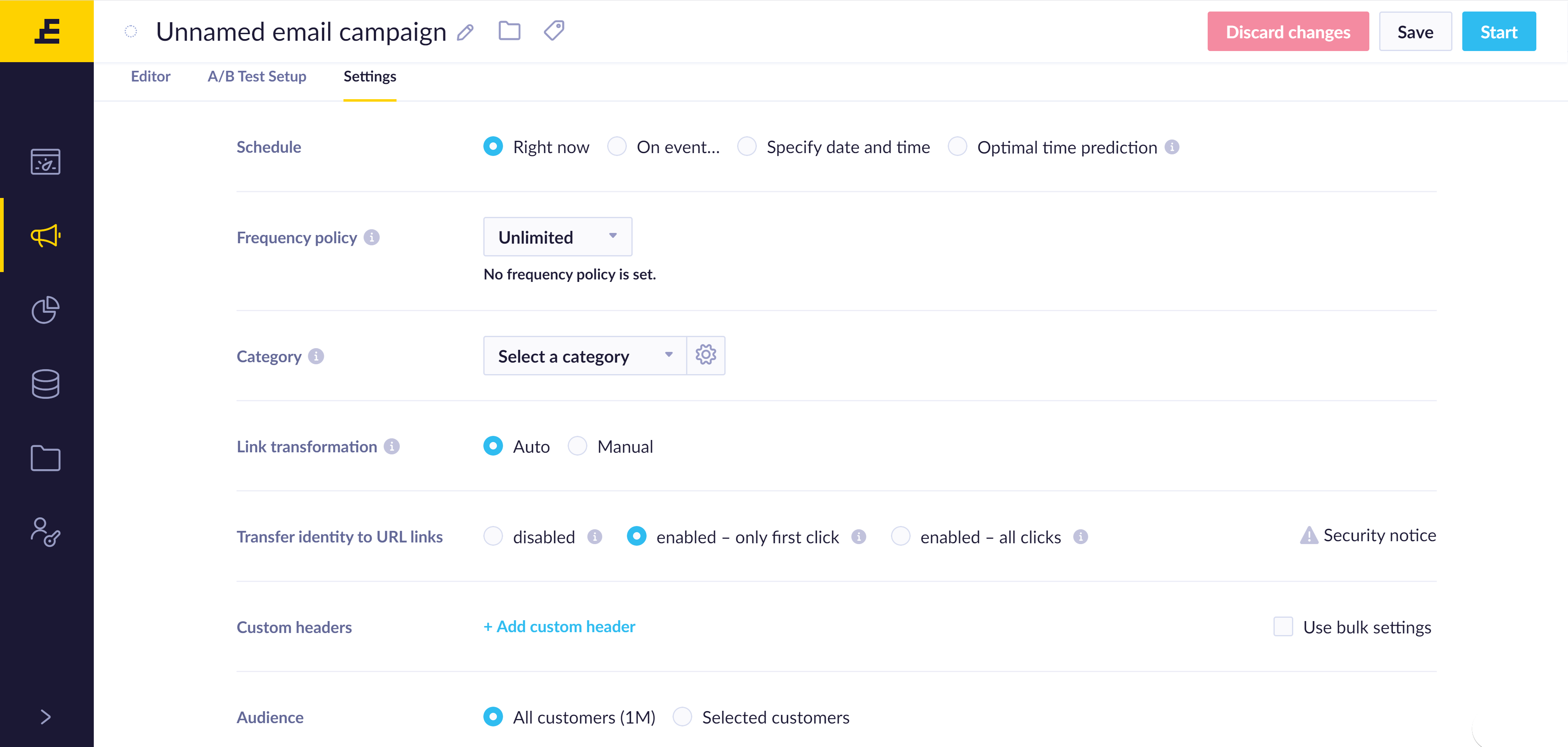
| Function | Description |
|---|---|
| Schedule (only visible when creating the email in email campaigns) | You can send the email: - Right after launching the campaign - Every time a specified event is tracked for each customer - On a specified day and time - At the predicted optimal time when the customer is most likely to either open or click in the email. Learn more about how to use optimal send time |
| Recipient (only visible when creating the email in a scenario) | Default option Customers matching campaign sends the email to all customers who enter the email node in the scenario. Email address is extracted from customer attribute - email.Set recipient manually: Lets you define a specific email address (or Jinja) that will be the recipient of this email. Use this to get daily reports to your email or when you need to use other properties than email to send the email. Review the Custom email recipients section for details on limitations.Important: We don't support or recommend adding multiple email addresses into the "Recipient's email address" field when setting recipients manually. Use one email address per field. |
| Frequency policy | Defines the number of emails that a customer can receive within a specified timeframe. Read more about how to create frequency policies . |
| Category (group) | Choose which consent is required for a customer to receive this campaign. Read more on consent management. If you don't use consent yet, you will see the campaign groups setting. |
| UTM | Define the UTM tags utm_campaign, utm_medium, and utm_source. Read more about UTM parameters. |
| Custom headers | You can define your own headers. This is an advanced feature that only affects the background processes of email campaigns. You can read more about email headers. This isn't the same as pre-headers, which is the text visible in inboxes right after the subject. Check the Use bulk settings box if you're sending bulk emails to multiple people. Otherwise, the email will likely go to the recipient's spam folder. Read more in our Email Deliverability tips article. |
| Audience (only in email campaigns) | Define your custom audience that will receive this email campaign. You can use our standard customer and event filters. You can also filter your audience on a project level through Email list hygiene filter. |
| Transfer identity to URL links | The default setting means only the first click on your URL link will cause customer identification on your website. For each scenario run, a unique token is created per individual email. We highly recommend using the default setting for security purposes and to prevent corrupting customer data. You can also select an option to disable all identity transfers or enable all clicks. |
Custom headers support
Custom headers aren't supported by Sendsay email provider.
Transfer identity to URL - limitations
- Mobile SDK doesn't support IITT and TIFC, so events through the phone won't be tracked.
- Jinja code is only supported for IITT.
- When you select
enabled - only first click, parameterxnpe_tifcwill contain the customer token and be added to the URL. - When you select
enabled - all clicks, parameteriittwill contain the customer token and be added to the URL.
Pre-populate settings from a template
When creating an email template within the Asset manager, you can enable template settings to predefine some campaign settings directly within the template. These settings include:
- Link transformation
- Transfer identity to URL links
- Custom headers
- Custom Campaign Tracking attributes
If you create a campaign using a template with these settings enabled and defined, this will pre-populate and pre-configure your campaign settings. This means you don't have to configure the campaign settings every time for the same template.
Read more in the Asset Manager article.
Use custom recipient
If you prefer to pick a different property than the standard customer attribute "email," you can use Custom Recipient. If you have a property called secondary_email or father_email (for students), you can tell the campaign to use this property instead of the "email" one. You can specify, for example, {{customer.secondary_email}}, and the campaigns will be sent to the value stored in the other attribute.
Important considerations for custom recipients
If you're going to use this feature and send an email to someone other than the original customer, it's best to set the identity tracking setting to "none." This prevents the cookie from being merged with the original customer if the recipient clicks something in the email.
You need to fill in the customer attribute value for the recipient and the same for the name. If you have a custom name like {{customer.secondary_email_holder_name}}, you need to specify that.
Key points about custom recipients
- Every profile is tied to one "email" property. This is the standard property used for a customer, assuming one person will only have one email for communication.
Important
Unless you have other requirements where you need to send the email to a value other than the one stored in the email property, don't use custom recipient.
- Since "email" is our "reserved" attribute, all consent management flows are tied to it. This means consent isn't followed if you use a secondary email.
- Let's say the user has email
[email protected]and consented to newsletters. This means whether the secondary email person has said yes or no, you would still target them for all comms if you specify the custom recipient. You are using consent for the profile, and each profile only has one value for consent.
- Let's say the user has email
- You can use Jinja in both "Recipient's email address" and "Recipient's name to display" fields. These fields can only hold one property and not a list.
Warning about custom email recipient
Using custom email recipients with "Set recipient manually" may disable the automatic check of customer consents and email policy.
Specifically, if your custom recipient or its rendered Jinja value is different from the customer's email property, there will be no validation of consents or email policy for this customer. If the custom recipient equals the customer's email property, normal validation will apply.
Be very careful if you plan to use a custom recipient for more than one customer because you might:
- Send emails to customers without validating their consent (GDPR breach).
- Send emails to customers too frequently (no validation of policy).
If you have no other option and must use a custom recipient, we recommend implementing a scenario condition node to check for correct consents and email frequency. For more details, contact our support.
Use optimal send time
If you choose the optimal send time in the Schedule, you can set it up in the same way as in a Wait node in Scenarios.
Based on your customer's past behavior, the optimal send time option under the Schedule setting lets you automatically send out email campaigns to individual customers at a time when they're most likely to click or open your email. The time is rounded to an hour. Learn more about Optimal send time

Videos in emails
Most popular email client apps don't support embedded videos in emails. While it's technically possible to embed videos using Engagement Visual Builder (provided by BeeFree) or HTML Builder, we don't recommend it because these videos aren't accessible to most users through emails. In the best case, users can see a fallback static image.
Consider your users' devices when planning to embed videos in emails. Most users access their emails through mobile or handheld devices, leading to a poor user experience due to data connection quality and mobile data consumption.
To learn more about using embedded videos in emails, refer to guide on embedding videos.
Test your email
There are various options for testing your email template before launching a campaign. Learn more in our email testing article. We recommend using at least one testing option before launching the live campaign.
Set up A/B testing
For email campaigns created via scenarios, A/B tests are configured using the dedicated A/B test operator node.
To set up an A/B test for Email campaigns, navigate to the A/B Test Setup tab under DESIGN. You can choose between two types of tests:
- Automatic winner distribution
- Custom distribution
Read more on A/B tests in our A/B testing guide.
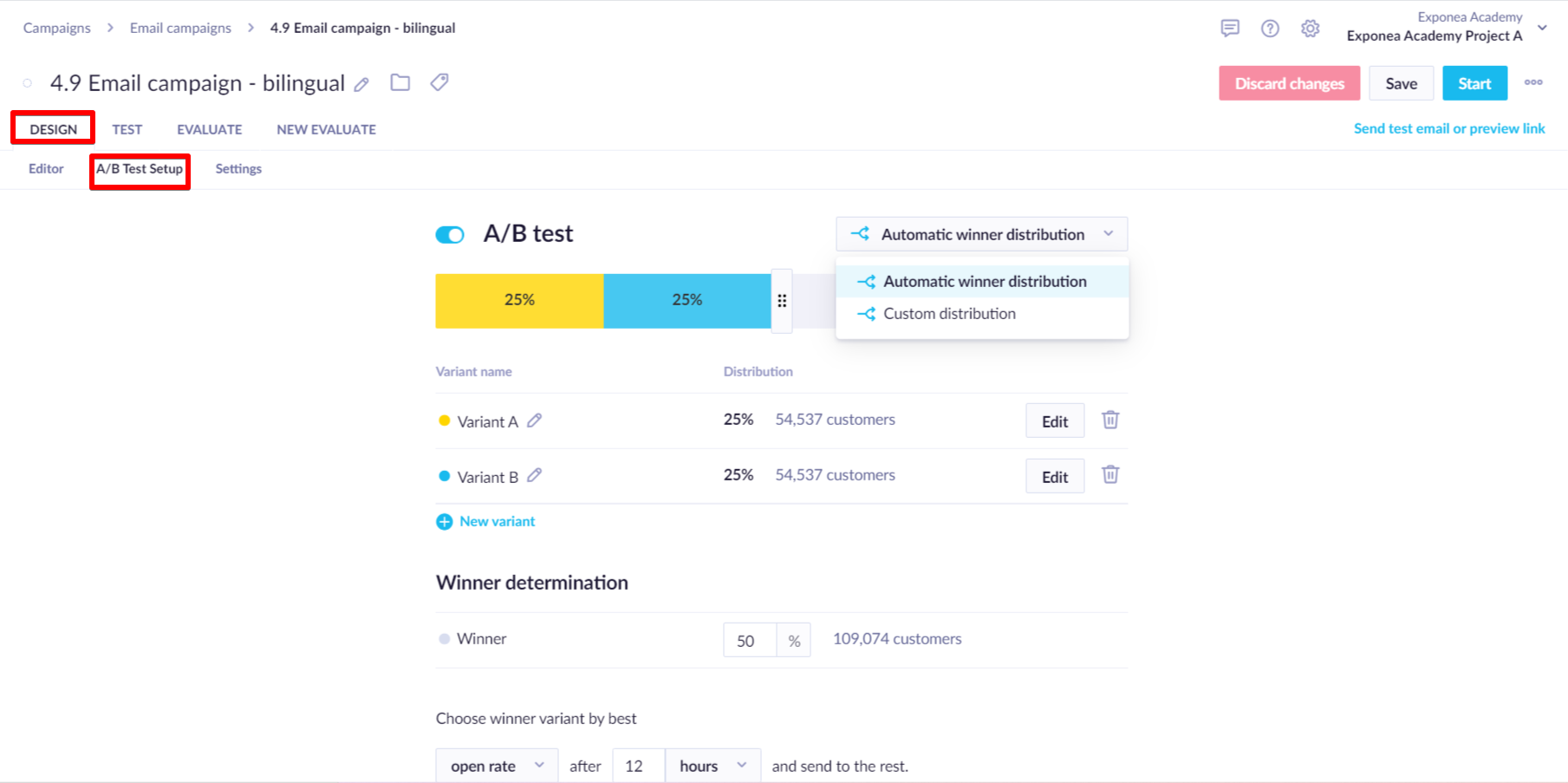
To set up A/B testing, you have to enable the A/B testing feature by turning the button on in the set-up or by clicking the "Enable A/B test" button.

To navigate between the designs for each variant or add new variants use the A/B test menu in the top right of your email editor. You can switch between the different variants and design the campaign for each version separately.

Evaluation
This dashboard will be removed in the upcoming months
The data in this dashboard may differ from the new Performance dashboards due to different calculation methods. We recommend using the new Performance dashboards for more accurate insights.
After starting a campaign you will be able to evaluate its performance. Under the NEW EVALUATE tab, you will find an out-of-the-box dashboard containing different data and tools that are useful for evaluating your campaign. Under the Results sub-tab, you will find all key metrics for evaluating your email campaign in a comprehensive and easy-to-read layout. Clicking on the Click map sub-tab will allow you to preview and use click heatmaps for analyzing your customers' interactions with the campaign.
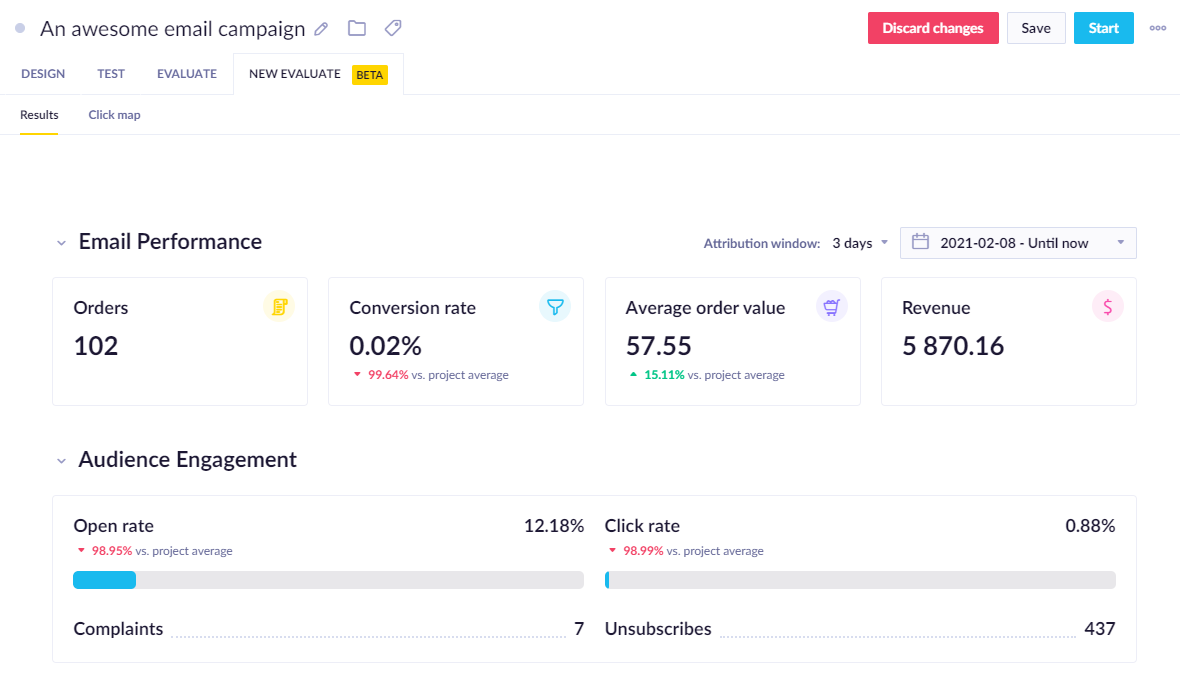
Automatic bot detection in emails
The automatic bot detection feature checks for bots scanning content and email links to identify spam and phishing emails. It helps tackle the issue of opens/clicks that are generated by bots rather than real users. Email opens are an unreliable metric as privacy standards have evolved, so clicks provide much better insight into how your email campaigns are performing.
We use the honeypot link solution. It's based on adding an invisible link that real humans can't click, but bots do. Every tracked click on the honeypot link is identified with a status containing a special value clicked_honeypot. This feature doesn't suppress any events but provides the necessary data to let your analytics sort it out.
This feature won't identify 100% of bots because this isn't technically possible. There's no universal solution, and bots are constantly changing and trying to identify themselves as real humans to prevent being identified by spam creators.
You can turn this feature on/off in project settings under Campaigns > Channels > Email > Automatic bot detection. After turning it on, it automatically starts identifying bots with a specific status.
Reliable email clicks
We developed the Reliable Email Clicks feature to keep up with ever-changing email privacy standards and help with evaluating click behavior.
Based on honeypot clicks (from the automatic bot detection feature) or other factors (such as the speed of consecutive clicks and recognized bot user agents), the platform recognizes non-human behavior. Bot-generated clicks are automatically filtered out, letting you focus exclusively on clicks from legitimate human users. The reliable email clicks feature also works without automatic bot detection turned on.
This option is available in email click map or predefined email evaluation dashboard. By default, the toggle is turned on to provide reliable and trustworthy data for your evaluation.
By enabling the Reliable Email Clicks filter, you can ensure that metrics more accurately reflect genuine user engagement, free from bot activity influence. However, if you need to include bot clicks for specific purposes or research, you can disable the filter with a single click.
When a user-agent is identified as a bot, the property bot = true is added to the campaign event, and it's subsequently excluded in reporting.
Note
IPs that click on the honeypot link are flagged as a bot for 1 hour. Therefore, the property `bot = true is added to campaign events coming in within that hour from that IP as well.
Tracking campaign performance
Email campaigns generate campaign events for all customers in the audience of the campaign, covering actions from the email being sent from Bloomreach Engagement to customers opening and clicking the email. Learn more about email campaign tracking and bounce management.
Clone to another project
This feature lets you clone Email campaigns to other projects to which you have access. Read more about cloning.
Most common email issues
If you are interested in how to fix certain issues in email campaigns, read Help with common email issues.
Dark mode
Dark mode in emails is a relatively new feature that hasn't been standardized yet. Popular email apps interpret it differently, and changes can be introduced anytime. The way an email appears is under the control of the email app—it can even decide to ignore styles that were included in the email.
Remember to always test your dark mode emails. Our email preview generator includes snapshots from email apps in dark mode.

You can refer to Darm mode email design by our visual builder provider BeeFree, with tips on creating dark mode-friendly emails.
Updated 6 months ago
